[English] 日本語
 Yorodumi
Yorodumi- PDB-5xiu: Crystal structure of RNF168 UDM2 in complex with Lys63-linked diu... -
+ Open data
Open data
- Basic information
Basic information
| Entry | Database: PDB / ID: 5xiu | ||||||
|---|---|---|---|---|---|---|---|
| Title | Crystal structure of RNF168 UDM2 in complex with Lys63-linked diubiquitin | ||||||
 Components Components |
| ||||||
 Keywords Keywords | TRANSFERASE/RIBOSOMAL PROTEIN / ubiquitin / TRANSFERASE-RIBOSOMAL PROTEIN complex | ||||||
| Function / homology |  Function and homology information Function and homology informationFormation of the ternary complex, and subsequently, the 43S complex / APC/C:Cdc20 mediated degradation of Cyclin B / SCF-beta-TrCP mediated degradation of Emi1 / APC-Cdc20 mediated degradation of Nek2A / ER Quality Control Compartment (ERQC) / Regulation of PTEN localization / Regulation of pyruvate metabolism / Downregulation of ERBB2:ERBB3 signaling / IRAK2 mediated activation of TAK1 complex / SMAD2/SMAD3:SMAD4 heterotrimer regulates transcription ...Formation of the ternary complex, and subsequently, the 43S complex / APC/C:Cdc20 mediated degradation of Cyclin B / SCF-beta-TrCP mediated degradation of Emi1 / APC-Cdc20 mediated degradation of Nek2A / ER Quality Control Compartment (ERQC) / Regulation of PTEN localization / Regulation of pyruvate metabolism / Downregulation of ERBB2:ERBB3 signaling / IRAK2 mediated activation of TAK1 complex / SMAD2/SMAD3:SMAD4 heterotrimer regulates transcription / PTK6 Regulates RTKs and Their Effectors AKT1 and DOK1 / Gap-filling DNA repair synthesis and ligation in GG-NER / Fanconi Anemia Pathway / Endosomal Sorting Complex Required For Transport (ESCRT) / Negative regulation of FLT3 / Synthesis of active ubiquitin: roles of E1 and E2 enzymes / Regulation of expression of SLITs and ROBOs / IRAK1 recruits IKK complex / IRAK1 recruits IKK complex upon TLR7/8 or 9 stimulation / Downregulation of ERBB4 signaling / E3 ubiquitin ligases ubiquitinate target proteins / Downregulation of TGF-beta receptor signaling / TGF-beta receptor signaling in EMT (epithelial to mesenchymal transition) / Stabilization of p53 / NOTCH3 Activation and Transmission of Signal to the Nucleus / Negative regulators of DDX58/IFIH1 signaling / Alpha-protein kinase 1 signaling pathway / Pexophagy / JNK (c-Jun kinases) phosphorylation and activation mediated by activated human TAK1 / Translesion synthesis by REV1 / Downregulation of SMAD2/3:SMAD4 transcriptional activity / Negative regulation of FGFR3 signaling / Negative regulation of FGFR4 signaling / Translesion synthesis by POLK / Regulation of NF-kappa B signaling / Negative regulation of FGFR1 signaling / Negative regulation of FGFR2 signaling / Regulation of TP53 Activity through Methylation / Formation of a pool of free 40S subunits / NRIF signals cell death from the nucleus / Translesion synthesis by POLI / Regulation of BACH1 activity / Recognition of DNA damage by PCNA-containing replication complex / p75NTR recruits signalling complexes / Interferon alpha/beta signaling / Negative regulation of MAPK pathway / Spry regulation of FGF signaling / SRP-dependent cotranslational protein targeting to membrane / Regulation of TP53 Degradation / Translesion Synthesis by POLH / Activated NOTCH1 Transmits Signal to the Nucleus / Formation of TC-NER Pre-Incision Complex / Major pathway of rRNA processing in the nucleolus and cytosol / Negative regulation of MET activity / TRAF6-mediated induction of TAK1 complex within TLR4 complex / IRAK2 mediated activation of TAK1 complex upon TLR7/8 or 9 stimulation / Termination of translesion DNA synthesis / Nonsense Mediated Decay (NMD) independent of the Exon Junction Complex (EJC) / Autodegradation of Cdh1 by Cdh1:APC/C / APC/C:Cdc20 mediated degradation of Securin / Senescence-Associated Secretory Phenotype (SASP) / Josephin domain DUBs / DNA Damage Recognition in GG-NER / Dual Incision in GG-NER / Ubiquitin-Mediated Degradation of Phosphorylated Cdc25A / Ubiquitin-dependent degradation of Cyclin D / Regulation of TBK1, IKKε (IKBKE)-mediated activation of IRF3, IRF7 / AUF1 (hnRNP D0) binds and destabilizes mRNA / Downregulation of ERBB2 signaling / Dual incision in TC-NER / Oncogene Induced Senescence / PINK1-PRKN Mediated Mitophagy / Nonsense Mediated Decay (NMD) enhanced by the Exon Junction Complex (EJC) / Cdc20:Phospho-APC/C mediated degradation of Cyclin A / SCF(Skp2)-mediated degradation of p27/p21 / N-glycan trimming in the ER and Calnexin/Calreticulin cycle / TNFR1-induced NF-kappa-B signaling pathway / Assembly of the pre-replicative complex / CDK-mediated phosphorylation and removal of Cdc6 / HDR through Homologous Recombination (HRR) / Gap-filling DNA repair synthesis and ligation in TC-NER / Inactivation of CSF3 (G-CSF) signaling / TCF dependent signaling in response to WNT / Metalloprotease DUBs / Formation of Incision Complex in GG-NER / Activation of IRF3, IRF7 mediated by TBK1, IKKε (IKBKE) / EGFR downregulation / Translation initiation complex formation / Ribosomal scanning and start codon recognition / translation at postsynapse / Autodegradation of the E3 ubiquitin ligase COP1 / MAP3K8 (TPL2)-dependent MAPK1/3 activation / G2/M Checkpoints / Degradation of AXIN / Regulation of FZD by ubiquitination / Regulation of TNFR1 signaling / Asymmetric localization of PCP proteins / APC/C:Cdh1 mediated degradation of Cdc20 and other APC/C:Cdh1 targeted proteins in late mitosis/early G1 / Regulation of RUNX3 expression and activity / Regulation of RAS by GAPs Similarity search - Function | ||||||
| Biological species |  Homo sapiens (human) Homo sapiens (human) | ||||||
| Method |  X-RAY DIFFRACTION / X-RAY DIFFRACTION /  SYNCHROTRON / SYNCHROTRON /  MOLECULAR REPLACEMENT / Resolution: 1.8 Å MOLECULAR REPLACEMENT / Resolution: 1.8 Å | ||||||
 Authors Authors | Takahashi, T.S. / Sato, Y. / Fukai, S. | ||||||
 Citation Citation |  Journal: Nat Commun / Year: 2018 Journal: Nat Commun / Year: 2018Title: Structural insights into two distinct binding modules for Lys63-linked polyubiquitin chains in RNF168. Authors: Takahashi, T.S. / Hirade, Y. / Toma, A. / Sato, Y. / Yamagata, A. / Goto-Ito, S. / Tomita, A. / Nakada, S. / Fukai, S. | ||||||
| History |
|
- Structure visualization
Structure visualization
| Structure viewer | Molecule:  Molmil Molmil Jmol/JSmol Jmol/JSmol |
|---|
- Downloads & links
Downloads & links
- Download
Download
| PDBx/mmCIF format |  5xiu.cif.gz 5xiu.cif.gz | 70.6 KB | Display |  PDBx/mmCIF format PDBx/mmCIF format |
|---|---|---|---|---|
| PDB format |  pdb5xiu.ent.gz pdb5xiu.ent.gz | 50.9 KB | Display |  PDB format PDB format |
| PDBx/mmJSON format |  5xiu.json.gz 5xiu.json.gz | Tree view |  PDBx/mmJSON format PDBx/mmJSON format | |
| Others |  Other downloads Other downloads |
-Validation report
| Summary document |  5xiu_validation.pdf.gz 5xiu_validation.pdf.gz | 429.3 KB | Display |  wwPDB validaton report wwPDB validaton report |
|---|---|---|---|---|
| Full document |  5xiu_full_validation.pdf.gz 5xiu_full_validation.pdf.gz | 429.2 KB | Display | |
| Data in XML |  5xiu_validation.xml.gz 5xiu_validation.xml.gz | 8.5 KB | Display | |
| Data in CIF |  5xiu_validation.cif.gz 5xiu_validation.cif.gz | 11.4 KB | Display | |
| Arichive directory |  https://data.pdbj.org/pub/pdb/validation_reports/xi/5xiu https://data.pdbj.org/pub/pdb/validation_reports/xi/5xiu ftp://data.pdbj.org/pub/pdb/validation_reports/xi/5xiu ftp://data.pdbj.org/pub/pdb/validation_reports/xi/5xiu | HTTPS FTP |
-Related structure data
| Related structure data |  5xisC  5xitC  5ydkC  2fidS C: citing same article ( S: Starting model for refinement |
|---|---|
| Similar structure data |
- Links
Links
- Assembly
Assembly
| Deposited unit | 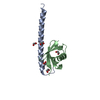
| ||||||||
|---|---|---|---|---|---|---|---|---|---|
| 1 | 
| ||||||||
| Unit cell |
|
- Components
Components
| #1: Protein/peptide | Mass: 5925.677 Da / Num. of mol.: 1 / Fragment: UNP residues 419-462 Source method: isolated from a genetically manipulated source Source: (gene. exp.)  Homo sapiens (human) / Gene: RNF168 / Plasmid: pCOLD-GST / Production host: Homo sapiens (human) / Gene: RNF168 / Plasmid: pCOLD-GST / Production host:  References: UniProt: Q8IYW5, RING-type E3 ubiquitin transferase | ||
|---|---|---|---|
| #2: Protein | Mass: 8576.831 Da / Num. of mol.: 1 Source method: isolated from a genetically manipulated source Source: (gene. exp.)   | ||
| #3: Chemical | ChemComp-EDO / #4: Water | ChemComp-HOH / | |
-Experimental details
-Experiment
| Experiment | Method:  X-RAY DIFFRACTION / Number of used crystals: 1 X-RAY DIFFRACTION / Number of used crystals: 1 |
|---|
- Sample preparation
Sample preparation
| Crystal | Density Matthews: 2.5 Å3/Da / Density % sol: 50.73 % |
|---|---|
| Crystal grow | Temperature: 293 K / Method: vapor diffusion, sitting drop / pH: 8.5 Details: 25% PEG3350, 0.1 M Tris-HCl (pH8.5), 0.2 M Ammonium Acetate |
-Data collection
| Diffraction | Mean temperature: 100 K |
|---|---|
| Diffraction source | Source:  SYNCHROTRON / Site: SYNCHROTRON / Site:  SPring-8 SPring-8  / Beamline: BL41XU / Wavelength: 1 Å / Beamline: BL41XU / Wavelength: 1 Å |
| Detector | Type: DECTRIS PILATUS3 6M / Detector: CMOS / Date: Jun 7, 2016 |
| Radiation | Protocol: SINGLE WAVELENGTH / Monochromatic (M) / Laue (L): M / Scattering type: x-ray |
| Radiation wavelength | Wavelength: 1 Å / Relative weight: 1 |
| Reflection | Resolution: 1.8→50 Å / Num. obs: 14042 / % possible obs: 99.3 % / Redundancy: 7.7 % / Rsym value: 0.137 / Net I/σ(I): 20.7 |
| Reflection shell | Resolution: 1.8→1.83 Å / Redundancy: 6.3 % / Mean I/σ(I) obs: 2.7 / Rsym value: 0.523 / % possible all: 99.2 |
- Processing
Processing
| Software |
| ||||||||||||||||||||||||||||||||||||||||||
|---|---|---|---|---|---|---|---|---|---|---|---|---|---|---|---|---|---|---|---|---|---|---|---|---|---|---|---|---|---|---|---|---|---|---|---|---|---|---|---|---|---|---|---|
| Refinement | Method to determine structure:  MOLECULAR REPLACEMENT MOLECULAR REPLACEMENTStarting model: 2FID Resolution: 1.8→50 Å / SU ML: 0.18 / Cross valid method: FREE R-VALUE / σ(F): 1.38 / Phase error: 19.23
| ||||||||||||||||||||||||||||||||||||||||||
| Solvent computation | Shrinkage radii: 0.9 Å / VDW probe radii: 1.11 Å | ||||||||||||||||||||||||||||||||||||||||||
| Refinement step | Cycle: LAST / Resolution: 1.8→50 Å
| ||||||||||||||||||||||||||||||||||||||||||
| Refine LS restraints |
| ||||||||||||||||||||||||||||||||||||||||||
| LS refinement shell |
| ||||||||||||||||||||||||||||||||||||||||||
| Refinement TLS params. | Method: refined / Origin x: 7.8914 Å / Origin y: 21.94 Å / Origin z: 8.4131 Å
| ||||||||||||||||||||||||||||||||||||||||||
| Refinement TLS group | Selection details: all |
 Movie
Movie Controller
Controller




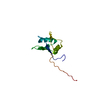
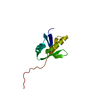
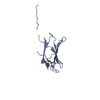
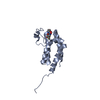


 PDBj
PDBj





























